|
|
|
After further consideration, I decided to use a loop of 3/32 inch OD cable to provide additional leg support. The loop has the advantage in that one can use two light weight thimbles and nicopress, where as, a single 1/8 inch OD cable would require at least two tangs and thimbles, and four nicopress per leg. A loop of 3/32 inch OD is equal to a single strand of 1/8 inch OD in strength. Since a loop is being used there is no leg twisting and or toe in change with gear leg deflection as the cable can slip a little in the thimble. Single cable use requires four tangs or a more complicated fitting to prevent twisting. With the loop the analysis is the same for the single 1/8 inch OD cable. |
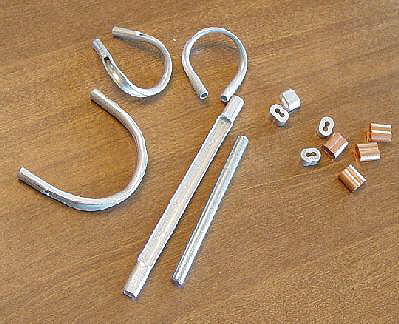 The parts kit, minus the cable, is shown to the left. The thimbles were made from 1/8 and 3/16 inch ID soft aluminum tubing. At least half of the tubing circumference was filed away except on the ends to save weight and for easier bending to shape and cable passing. To ensure that two 3/32 inch OD cables could lie side by side, the 3/16 inch ID tube was expanded out to 1/4 inch radius with a mandrel made from a 1/4 inch bolt. The thimble ends were ovalized.
The parts kit, minus the cable, is shown to the left. The thimbles were made from 1/8 and 3/16 inch ID soft aluminum tubing. At least half of the tubing circumference was filed away except on the ends to save weight and for easier bending to shape and cable passing. To ensure that two 3/32 inch OD cables could lie side by side, the 3/16 inch ID tube was expanded out to 1/4 inch radius with a mandrel made from a 1/4 inch bolt. The thimble ends were ovalized.
Copper nicopress were used for clamping the cable ends. To save weight aluminum nicopress were cut into two pieces and used for cable tensioning. |
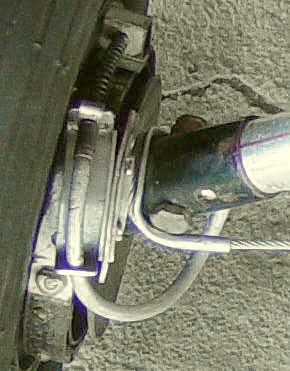 The thimble and cable were passed over the axle connector and down underneath the attachment bolt. The thimble allows the cable to slip without the cable chaffing on the bolt head and/or nut.
The thimble and cable were passed over the axle connector and down underneath the attachment bolt. The thimble allows the cable to slip without the cable chaffing on the bolt head and/or nut.
|
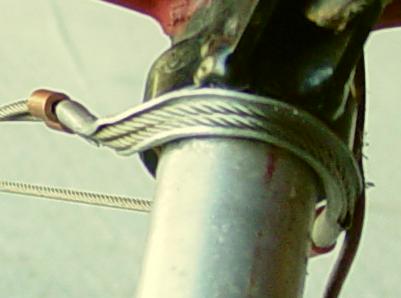 The upper thimble is shown on the opposite gear leg with the copper nicopress slipped into position. By doing a double pass over the gear leg one nicopress can be neatly placed on each side and this meets the double nicopress criterion.
The upper thimble is shown on the opposite gear leg with the copper nicopress slipped into position. By doing a double pass over the gear leg one nicopress can be neatly placed on each side and this meets the double nicopress criterion.
|
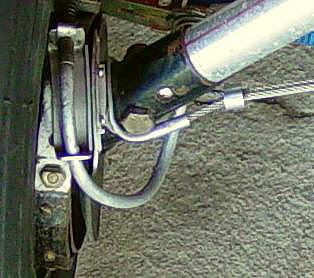 This shows the half aluminum nicopress slid down close to the lower thimble. There are two reasons for using these half thimbles. They keep the cables close to each other and at the same time they help to pretension the cable.
This shows the half aluminum nicopress slid down close to the lower thimble. There are two reasons for using these half thimbles. They keep the cables close to each other and at the same time they help to pretension the cable.
|
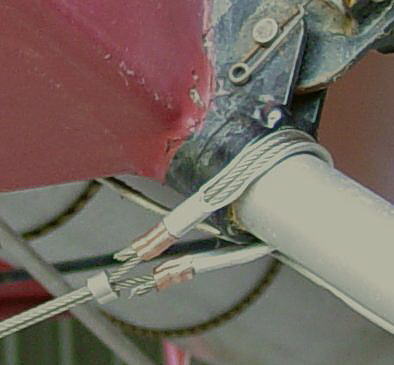 A view of the upper thimble with the copper nicopress in place, the cable in tension, and the half aluminum nicopress in position.
A view of the upper thimble with the copper nicopress in place, the cable in tension, and the half aluminum nicopress in position.
|
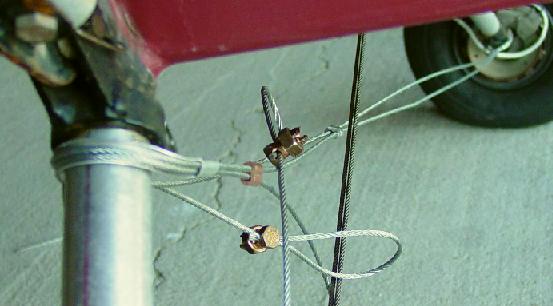 The above photo shows the second cable in place prior to the addition of pre tensioning. The cable has been threaded through the thimbles and nicopress. The cable free ends have been looped with the use of slotted electrical connectors. |
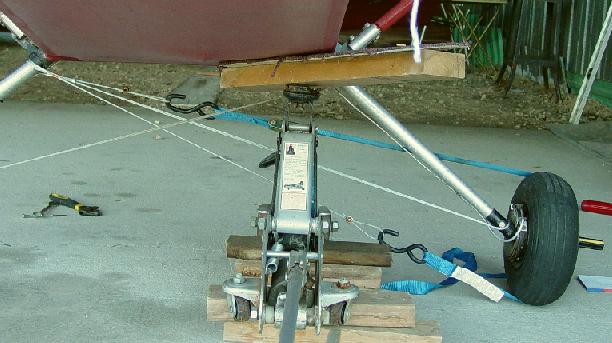
To prepare for cable pre tensioning, all load bearing weight was removed from the leg. A screw driver was slid into the outer axle tube opening. Hooks on the end of a ratchet strap wrench were placed in the cable loops and the strap was run over the wheel and under the screw driver. This way the ratchet pulled the cable through the thimbles and nicopress until the desired tension was found. This process is some what subjective. Before a tension increase, the half nicopress were moved to mid span. After the increase, the lower half nicopress was moved toward the wheel as far as it would go. Then the second nicopress was moved in the opposite direction. When the cable was strummed, and it gave a nice true bass sound the copper nicopress were compressed. Then the cable free ends were cut away and the half nicopress were fixed in place with JB Weld. |

Here is the finished product. The cables were wrapped and wire tied so they can not chaff on each other at the cross over point. Total added weight was five ounces, and total expenditure was less than $20.00. Will I test this set up to see if it really works? I hope not. |
|
One flight with a take off and landing in a gusty cross wind indicates there was no change in handling characteristics. Taxiing out and back, the modification caused the ride to be a little more harsh. It is too early to tell how it is going to hold up. |
|
To date, there have been 59 takeoffs and landings on the modified landing gear. The last landing was in a bean field and the fuselage was towed eight miles to the airport on the main gear. At this time, it looks like the modification is going to hold up just fine, as there has been no cable stretch. One of the nice things about this modification is that it transfers load from the lower leg to the base of the opposite leg. In doing so it reduces side loading to the leg sockets and keeps the legs from spreading. If one drops a wheel in a hole, this modification will do nothing to keep the leg from bending and/or folding back. I look at this as a nice safety feature. As the leg bends or folds, it absorbs energy, and reduces forward velocity, and reduces the peak g load felt by the pilot. |